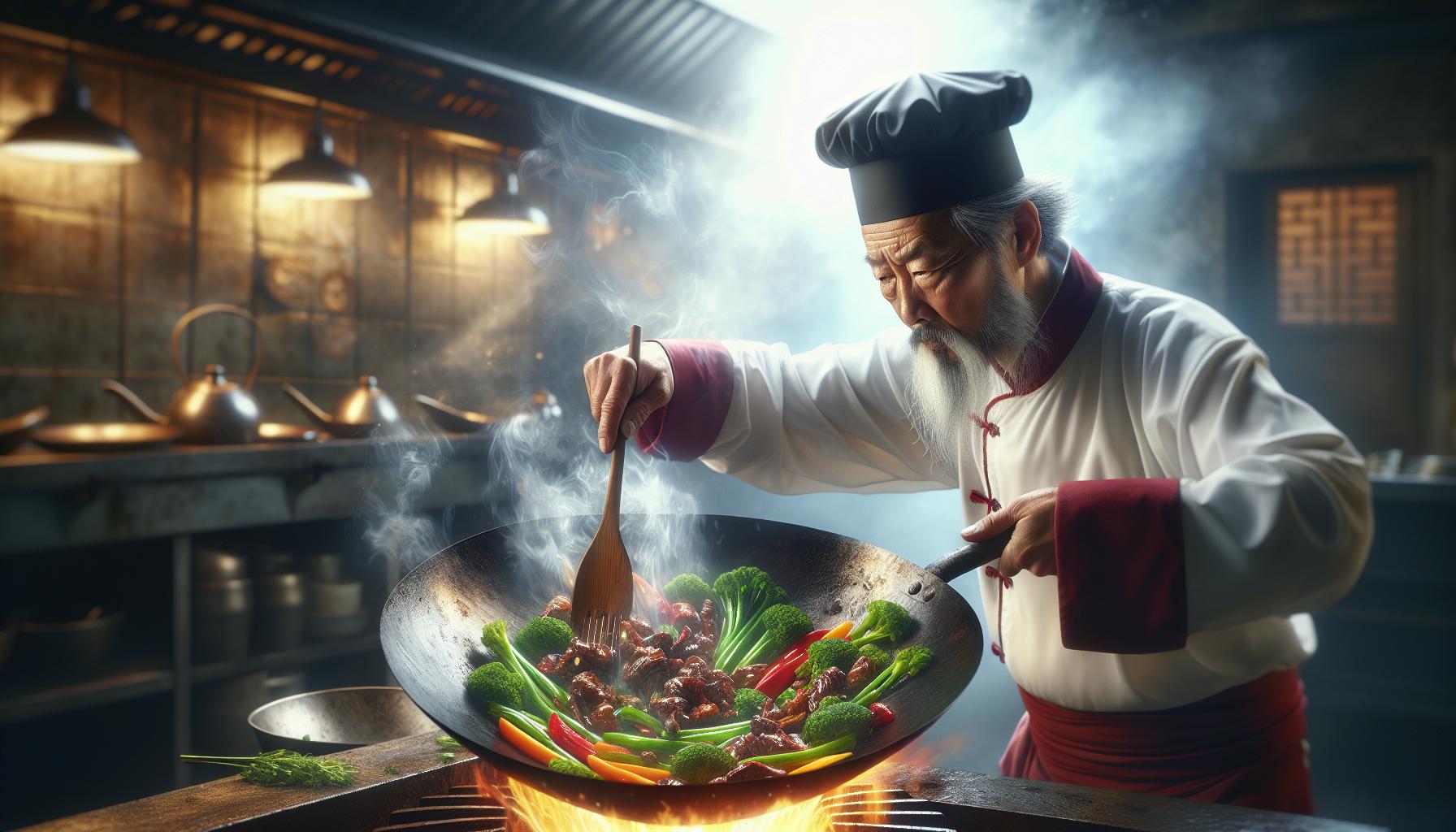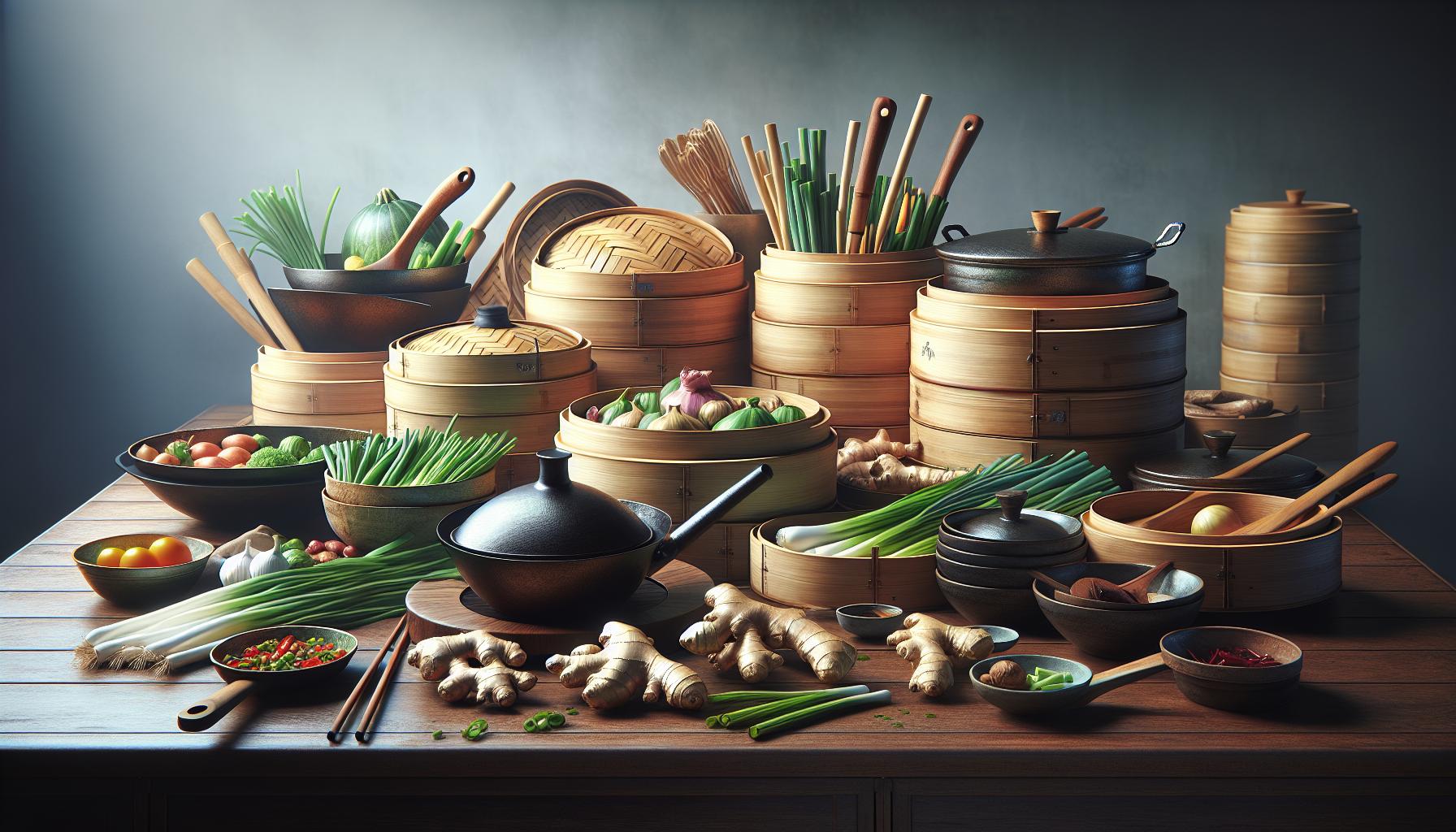
Chinese cuisine has captivated food lovers for thousands of years with its intricate cooking techniques and bold flavors. From the sizzling woks of street vendors to the precise knife work in high-end restaurants these methods have been perfected through generations of culinary artistry.
The art of Chinese cooking extends far beyond just tossing ingredients into a pan. It’s a symphony of techniques like “wok hei” (the elusive breath of the wok) stir-frying blanching and steaming that transform simple ingredients into extraordinary dishes. Whether it’s the dramatic toss of noodles through the air or the delicate pleating of dim sum these techniques require both skill and patience to master.
Chinese Cooking Techniques
Authentic Chinese cooking relies on specific equipment that enhances traditional techniques and flavors. The right tools enable proper heat distribution, ingredient handling and precise cooking control.
Traditional Wok Selection
Carbon steel woks form the cornerstone of Chinese cooking, offering superior heat conductivity and natural non-stick properties. A 14-inch flat-bottom wok works best for home gas stoves, while round-bottom woks suit traditional Chinese pit stoves. The ideal wok thickness ranges between 1.5-2mm, providing durability without excessive weight. Properly seasoned woks develop a dark patina that prevents food from sticking and imparts the coveted “wok hei” flavor. Hand-hammered woks feature tiny indentations that help food stay in place during stir-frying.
Must-Have Kitchen Utensils
A Chinese kitchen demands specialized tools for authentic cooking techniques:
- Metal spatulas (wok chuan) feature a slightly curved edge for scraping wok surfaces
- Long wooden chopsticks measure 16 inches for safe deep-frying operations
- Spider strainers remove ingredients from hot oil or boiling water
- Bamboo steaming baskets stack for multiple-level cooking
- Chinese cleavers (cai dao) serve as all-purpose knives for chopping vegetables slicing meat dicing garlic
- Rice cookers maintain precise temperature control for perfect grain texture
- Clay pots retain heat for slow-cooking soups stews braised dishes
Each tool serves specific functions essential for executing traditional Chinese cooking methods efficiently.
Fundamental Stir-Frying Techniques

Stir-frying stands as the cornerstone of Chinese cooking techniques, combining rapid movements with precise timing to create dishes with optimal texture and flavor. This method transforms raw ingredients into perfectly cooked meals in minutes while preserving their nutritional value.
Wok Hei Mastery
Wok hei creates the distinctive smoky flavor found in professionally prepared Chinese dishes through high-heat cooking. The process involves lifting ingredients up the sides of the wok into the flames while maintaining consistent motion. Expert chefs achieve wok hei by heating their woks to 400°C (752°F) before adding oil in a thin stream along the sides. Proper wok hei technique includes:
- Tossing ingredients in a circular motion to expose them to intense heat
- Using quick flipping movements to prevent burning
- Maintaining constant movement to ensure even cooking
- Timing ingredient additions based on density and cooking speed
- Creating controlled flame bursts to enhance smokiness
Heat Control Methods
Chinese stir-frying relies on strategic heat management throughout the cooking process. The temperature zones in a wok include:
| Zone | Temperature (°C) | Primary Use |
|---|---|---|
| Center | 370-400 | Searing meat |
| Middle | 290-350 | Cooking vegetables |
| Sides | 200-250 | Keeping food warm |
- Starting with smoking-hot oil for meat searing
- Reducing heat when adding aromatics like garlic or ginger
- Adjusting flame intensity based on ingredient moisture content
- Moving ingredients between temperature zones for precise cooking
- Using residual heat for delicate items like leafy greens
Popular Chinese Cooking Methods

Chinese cuisine employs diverse cooking techniques that create distinct flavors and textures. Each method requires specific skills and equipment to achieve authentic results.
Steaming and Braising
Steaming preserves nutrients while infusing ingredients with delicate flavors. Traditional bamboo steamers stack multiple layers to cook several dishes simultaneously, from dim sum to whole fish. Steaming time varies by ingredient: vegetables take 3-5 minutes while proteins require 8-15 minutes.
Braising combines initial searing with slow cooking in liquid. Master stock braising uses aromatic bases of soy sauce, rice wine, ginger and star anise. Classic examples include red-braised pork belly (Hong Shao Rou) and Lion’s Head Meatballs, which simmer for 45-90 minutes until tender.
Deep-Frying and Pan-Frying
Deep-frying in Chinese cooking requires precise oil temperatures between 350-375°F (175-190°C). Ingredients undergo a two-stage frying process: initial frying at lower heat followed by high-heat finishing. Common applications include crispy spring rolls, sweet and sour dishes and Kung Pao chicken.
Pan-frying uses less oil at medium-high heat (300-325°F/150-165°C). This technique creates golden-brown crusts on potstickers, scallion pancakes and noodle dishes. The ideal pan-frying time ranges from 3-5 minutes per side depending on thickness.
Smoking and Roasting
Smoking infuses ingredients with complex flavors using tea leaves, rice or wood chips. Tea-smoked duck combines initial steaming with smoking over black tea leaves for 15-20 minutes. Traditional smoking temperatures maintain 180-200°F (82-93°C).
Roasting techniques produce signature dishes like Peking duck and char siu pork. The process involves air-drying ingredients for 4-6 hours before roasting at high temperatures (400-425°F/200-218°C). Periodic basting with honey-soy mixtures creates characteristic glossy exteriors.
Key Preparation Techniques

Chinese cuisine preparation demands precision in ingredient handling, seasoning timing and flavor development. These foundational techniques transform raw ingredients into dishes with authentic textures and tastes.
Knife Skills and Cutting Methods
Chinese knife techniques employ specific cutting patterns that enhance texture, ensure even cooking and create visually appealing presentations. The Chinese cleaver produces distinct cuts: julienne (2-3mm strips), dice (small cubes), slice (thin rectangular pieces) and shred (fine matchsticks). Professional chefs execute the “rock chop” method by pivoting the cleaver while keeping the tip on the cutting board, creating uniform pieces at rapid speed. Advanced techniques include the butterfly cut for meats, diagonal cuts for vegetables and roll-cutting for cylindrical ingredients like carrots. The size and shape of each cut influences cooking time, sauce absorption and mouthfeel of finished dishes.
Marinating and Velveting
Marinating infuses proteins with flavor through a combination of soy sauce, rice wine, ginger and garlic. The velveting technique creates the signature tender texture in Chinese stir-fried meats. Proteins soak in a mixture of egg white, cornstarch and rice wine for 30 minutes before cooking. Chefs blanch the marinated meat in oil at 180°F (82°C) or water at 175°F (79°C) for 45 seconds. This process seals moisture inside while creating a protective coating. Common velveting applications include chicken breast strips for Kung Pao chicken and beef slices for pepper steak. Premium restaurants velvet seafood like shrimp and scallops to maintain their delicate texture.
Seasoning and Sauce Creation
Chinese cuisine relies on precise seasoning combinations and sauce-making techniques to create complex flavor profiles. The mastery of these elements distinguishes authentic Chinese dishes from basic stir-fries.
Basic Sauce Combinations
Chinese sauces incorporate specific ingredient ratios to achieve signature flavors. Light soy sauce pairs with Shaoxing wine for a savory foundation in marinades. Dark soy sauce combines with oyster sauce to create rich brown sauces for braised dishes. A mixture of black vinegar garlic sauce enhances dumplings while chili oil blends with sesame paste produce distinctive Sichuan flavors. Common sauce bases include:
- Light soy sauce + ginger + garlic (for stir-fries)
- Oyster sauce + dark soy + sugar (for noodle dishes)
- Black vinegar + soy sauce + chili oil (for cold appetizers)
- Hoisin sauce + five spice powder (for roasted meats)
- Bean paste + garlic + scallion (for braised dishes)
Balancing Flavors
Chinese cooking maintains harmony through five essential taste elements: salty sweet sour bitter umami. Each component serves a specific purpose in flavor development:
- Salty elements: Light soy sauce fermented black beans salt
- Sweet elements: Rock sugar honey caramelized onions
- Sour elements: Rice vinegar citrus preserved vegetables
- Bitter elements: Chinese herbs dried orange peel bitter melon
- Umami elements: Dried mushrooms oyster sauce dried seafood
- Base seasonings (salt ginger garlic)
- Primary sauce components (soy sauce oyster sauce)
- Accent flavors (vinegar wine sugar)
- Finishing touches (sesame oil fresh herbs)
Regional Cooking Styles
Chinese cooking techniques vary significantly across regions, reflecting local ingredients, climate conditions and cultural preferences. Each region’s distinct methods contribute to China’s diverse culinary landscape.
Cantonese Techniques
Cantonese cuisine emphasizes fresh ingredients and light cooking methods that preserve natural flavors. Stir-frying in Cantonese cooking involves quick movements at high heat to maintain vegetables’ crispness while creating a glossy exterior on proteins. Steaming stands as a signature technique, particularly for seafood dishes like steamed fish with ginger and scallions. Cantonese chefs excel at roasting meats, demonstrated in dishes like char siu (barbecued pork) and crispy-skinned roast duck. The region’s dim sum preparation showcases delicate knife work through precise pleating techniques for dumplings like har gow and siu mai.
Sichuan Methods
Sichuan cooking centers on bold flavors created through unique preparation techniques. Dry-frying (gan bian) creates intensely flavored dishes by stir-frying ingredients until moisture evaporates. Double-frying generates the signature crispy texture in dishes like twice-cooked pork. Sichuan chefs utilize “fish-fragrant” technique, combining garlic, ginger, pickled chilies and broad bean paste to create complex layers of flavor. The “mala” cooking method combines Sichuan peppercorns with chilies to produce the region’s characteristic numbing spiciness. Hot pot preparation involves precise timing for ingredients cooked in spiced broths at varying temperatures.
Chinese cooking techniques represent a sophisticated culinary art form that’s been perfected over generations. Mastering these methods requires dedication precision and an understanding of how different elements work together to create extraordinary dishes.
The combination of proper tools specialized techniques and regional variations makes Chinese cuisine one of the world’s most diverse and celebrated cooking traditions. Whether it’s the high-heat drama of wok cooking the delicate art of dim sum or the complex balance of seasonings these techniques continue to influence modern cooking worldwide.
Anyone looking to explore authentic Chinese cooking will find that understanding these fundamental techniques opens up a world of culinary possibilities. With practice and patience these time-tested methods can transform simple ingredients into extraordinary meals that capture the essence of Chinese gastronomy.


